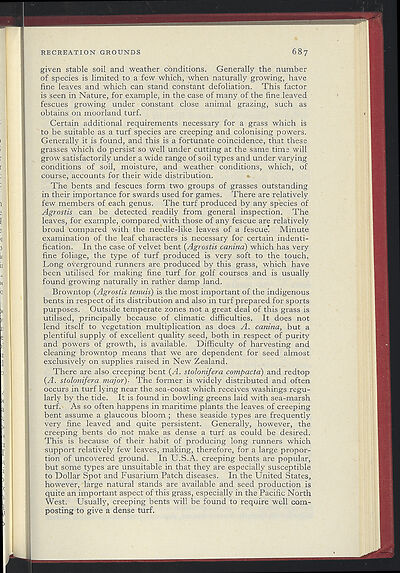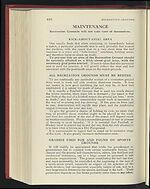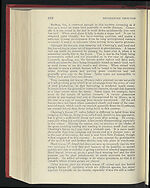1952-53
(721)
Download files
Complete book:
Individual page:
Thumbnail gallery: Grid view | List view

e
a
L
r
l
RECREATION GROUNDS
687
given stable soil and weather conditions. Generally the number
of species is limited to a few which, when naturally growing, have
fine leaves and which can stand constant defoliation. This factor
is seen in Nature, for example, in the case of many of the fine,leaved
fescues growing under constant close animal grazing, such as
obtains on moorland turf.
Certain additional requirements necessary for a grass which is
to be suitable as a turf species are creeping and colonising powers.
Generally it is found, and this is a fortunate coincidence, that these
grasses which do persist so well under cutting at the same.time will
grow satisfactorily under a wide range of soil types and under varying
conditions of soil, moisture, and weather conditions, which, of
course, accounts for their wide distribution.
Z.
The bents and fescues form two groups of grasses outstanding
in their importance for swards used for games. There are relatively
few members of each genus. The turf produced by any species of
Agrostis
can be detected readily from general inspection. The
leaves, for example, compared with those of any fescue are relatively
broad 'compared with the needle-like leaves of a fescue: Minute
examination of the leaf characters is necessary for certain indenti-
fication. In the case of velvet bent
(Agrostis canina)
which has very
fine foliage, the type of turf produced is very soft to the touch.
Long overground runners are produced by this grass, which have
been utilised for making fine turf for golf courses and is usually
found growing naturally in rather damp land.
Browntop
(Agrostis tenuis) is
the most important of the indigenous
bents in respect of its distribution and also in turf prepared for sports
purposes. Outside temperate zones not a great deal of this grass is
utilised, principally because of climatic difficulties. It does not
lend itself to vegetation multiplication as does
A.
canina,
but a
plentiful supply of excellent quality seed, both in respect of purity
and powers of growth, is available. Difficulty of harvesting and
cleaning browntop means that we are dependent for seed almost
exclusively on supplies raised in New Zealand.
There are also creeping bent
(A. stolonifera co?npacta)
and redtop
(A.
stolonifera major).
The former is widely distributed and often
occurs in turf lying near the sea-coast which receives washings regu-
larly by the tide. It is found in bowling greens laid with sea-marsh
turf. As so often happens in maritime plants the leaves of creeping
bent assume a glaucous bloom ; these seaside types are frequently
very fine leaved and quite persistent. Generally, however, the
creeping bents do not make as dense a turf as could be desired.
This is because of their habit of producing long runners which
support relatively few leaves, making, therefore, for a large propor-
tion of uncovered ground. In U.S.A. creeping bents are popular,
but some types are unsuitable in that they are especially susceptible
to Dollar Spot and Fusarium Patch diseases. In the United States,
however, large natural stands are available and seed production is
quite an important aspect of this grass, especially in the Pacific North
West. Usually, creeping bents will be found to req►zire well com-
posting to give a dense turf.
a
L
r
l
RECREATION GROUNDS
687
given stable soil and weather conditions. Generally the number
of species is limited to a few which, when naturally growing, have
fine leaves and which can stand constant defoliation. This factor
is seen in Nature, for example, in the case of many of the fine,leaved
fescues growing under constant close animal grazing, such as
obtains on moorland turf.
Certain additional requirements necessary for a grass which is
to be suitable as a turf species are creeping and colonising powers.
Generally it is found, and this is a fortunate coincidence, that these
grasses which do persist so well under cutting at the same.time will
grow satisfactorily under a wide range of soil types and under varying
conditions of soil, moisture, and weather conditions, which, of
course, accounts for their wide distribution.
Z.
The bents and fescues form two groups of grasses outstanding
in their importance for swards used for games. There are relatively
few members of each genus. The turf produced by any species of
Agrostis
can be detected readily from general inspection. The
leaves, for example, compared with those of any fescue are relatively
broad 'compared with the needle-like leaves of a fescue: Minute
examination of the leaf characters is necessary for certain indenti-
fication. In the case of velvet bent
(Agrostis canina)
which has very
fine foliage, the type of turf produced is very soft to the touch.
Long overground runners are produced by this grass, which have
been utilised for making fine turf for golf courses and is usually
found growing naturally in rather damp land.
Browntop
(Agrostis tenuis) is
the most important of the indigenous
bents in respect of its distribution and also in turf prepared for sports
purposes. Outside temperate zones not a great deal of this grass is
utilised, principally because of climatic difficulties. It does not
lend itself to vegetation multiplication as does
A.
canina,
but a
plentiful supply of excellent quality seed, both in respect of purity
and powers of growth, is available. Difficulty of harvesting and
cleaning browntop means that we are dependent for seed almost
exclusively on supplies raised in New Zealand.
There are also creeping bent
(A. stolonifera co?npacta)
and redtop
(A.
stolonifera major).
The former is widely distributed and often
occurs in turf lying near the sea-coast which receives washings regu-
larly by the tide. It is found in bowling greens laid with sea-marsh
turf. As so often happens in maritime plants the leaves of creeping
bent assume a glaucous bloom ; these seaside types are frequently
very fine leaved and quite persistent. Generally, however, the
creeping bents do not make as dense a turf as could be desired.
This is because of their habit of producing long runners which
support relatively few leaves, making, therefore, for a large propor-
tion of uncovered ground. In U.S.A. creeping bents are popular,
but some types are unsuitable in that they are especially susceptible
to Dollar Spot and Fusarium Patch diseases. In the United States,
however, large natural stands are available and seed production is
quite an important aspect of this grass, especially in the Pacific North
West. Usually, creeping bents will be found to req►zire well com-
posting to give a dense turf.
Set display mode to:
![]() Universal Viewer |
Universal Viewer | ![]() Mirador |
Large image | Transcription
Mirador |
Large image | Transcription
| Games and sports in the army > 1952-53 > (721) |
|---|
| Permanent URL | https://digital.nls.uk/248826881 |
|---|
| Description | 'Games and Sports in the Army' was an annual publication produced by the British War Office between the 1930s and 1960s. This included the Second World War. It outlines the rules and regulations for games and sports played by members of the armed forces. It features names and photographs of team members, and examples of contemporary advertising. |
|---|---|
| Shelfmark | GWB.52 |

